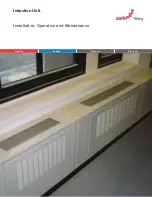
Operation of the microphone terminal MT 2005 (also refer to diagram 7)
When the microphone terminal is connected correctly to the CPA 2000 electro acoustics system and its
power is turned on, this is signaled by the POWER ON (13) indicator on the MT 2005. Pressing one of
the ZONE buttons (1 to 5) delegates the signal to the desired loudspeaker zone. The corresponding LED
lights. Pressing the button again cancels the signal routing and the LED goes out. The collective call button
“ALLE” (6) allows to assign the signal to all speaker zones at once while the reset button “LÖSCHEN” (7)
cancels the momentarily selected speaker zones. To transmit a call message you have to engage the call
button “SPRECHEN” (10) and keep it pressed while you are speaking into the microphone. If the
BUSY-LED (11) is lit, a prioritized message is being transmitted by the system and you cannot operate
the microphone terminal. During the transmission of a message the BUSY-LED (11) lights.
In case the “gong/alert” extension kit is installed, a gong signal is sent by pressing the GONG (8) button.
While the gong is sent, the LED on the GONG (8) button lights and if the system is set to “normal” priority,
the transmission of messages is not possible during this time. The gong signal ends automatically.
In case the “gong/alert” extension kit is installed, an alert signal is sent by pressing the ALARM (14) button.
While the alert signal is sent, the ALARM indicator (14) lights and if the system is set to “normal” priority,
the transmission of messages is not possible during this time. Releasing the button terminates the alert
signal.
In case the “voice message” extension kit is installed, voice messages are transmitted by pressing the
TEXT (9) button. While outputting voice messages, the LED on the TEXT (9) button lights and if the system
is set to “normal” priority the transmission of regular calls is not possible during this time. The voice
message ends automatically or it can be terminated by pressing the STOP (12) button for a few seconds.
For recording a voice message proceed as follows: Press the STOP, TEXT and TALK buttons simulta-
neously and keep them pressed during the recording of the message (i. e. “stop” has to be pressed first
and released last). The message has to be recorded at maximum recording level. The maximum recording
time is 1 minute. Once recorded, the message is preserved, even during a power outage. The message
can be erased by simultaneously pressing the STOP and TEXT keys.
Labeling of the microphone terminal
The microphone terminal’s printed labels are carried out in German (function keys: Löschen = Erase /
Stop / Alle = All / Gong / Text / Sprechen =Talk); the ZONE-buttons are not factory pre-labeled.
Custom-labeling of function keys and zone-keys is possible through the insertion of label strips. Thus
detach the right side panel to insert the function key-labels and the left side panel to insert the zone
key-labels.
You will find examples of different labeling strips within this owner’s manual. We recommend using a
typewriter or a computer printout when marking the label strips.
Checking the jumper settings and firmware revision number of a paging station is accomplished through
the use of a service software. Thus, you have to switch the microphone terminal’s power off and while
turning it on again, you have to keep the STOP [12] button pressed. The ON-LED [13] blinks in this mode.
When pressing the GONG [8] button, the set address is displayed via the Zone 1-LED (1 x blinking =
address 1, 2 x blinking = address 2, 3 x blinking = address 3).
Additionally, by pressing the Zone 5 [5] button the internal firmware revision number gets displayed. The
blinking Zone 1 - Zone 3 LEDs display the actual revision number (e. g. Zone 1 LED blinks once, the Zone
2 LED does not blink at all, and the Zone 3 LED blinks three times = firmware revision 1.03).
Switching the MT 2005’s power off disengages the service mode.
34
Summary of Contents for CPA 2000
Page 17: ...Bild 7 Sprechstelle MT 2005 17...
Page 18: ...18...
Page 35: ...diagram 7 terminal MT 2005 35...
Page 36: ...36...
Page 53: ...diagramme 7 terminal MT 2005 53...
Page 54: ...54...
Page 55: ......
Page 56: ......
Page 57: ......
















































